Unlocking the Secrets of Adult Dog House Training: A Guide to Success
Bringing an adult dog into your home can be a rewarding experience filled with love, companionship, and endless tail wags. Yet, one of the most vital skills to tackle when welcoming a new furry friend is house training. Unlike puppies, adult dogs often come with established habits, making the process both a challenge and an opportunity for growth. Whether you’ve recently adopted a rescue or are helping a friend’s pet adjust to a new environment, understanding the nuances of adult dog house training can pave the way for a harmonious household. In this article, we will explore practical tips, effective techniques, and the essential mindset needed to transform your adult dog into a well-mannered member of the family. Prepare to embark on a journey where patience, consistency, and love are your best allies!
Table of Contents
- Understanding the Adult Dogs Perspective on House Training
- Establishing a Consistent Routine for Success
- Choosing the Right Tools and Techniques for Effective Training
- Troubleshooting Common Challenges in Adult Dog House Training
- Q&A
- The Conclusion
Understanding the Adult Dogs Perspective on House Training
When it comes to house training an adult dog, it’s essential to consider their unique perspective. Unlike puppies, adult dogs come with established habits and experiences that shape their behavior. Many adult dogs might have been previously trained, but circumstances can lead to setbacks. For instance, a new environment, changes in routine, or health issues can disrupt their established bathroom habits. This makes it vital for guardians to approach training with patience and empathy, ensuring that their dog feels secure and understood during the process.
Effective house training relies on clear communication and positive reinforcement. To facilitate this, consider the following strategies:
- Consistent Schedule: Establish a regular routine for bathroom breaks to help the dog learn when and where it’s appropriate to go.
- Positive Reinforcement: Reward successes with treats or praise, reinforcing good behavior and strengthening the bond between dog and owner.
- Clear Signals: Teach the dog to use a consistent signal, like ringing a bell at the door, to communicate their need to go outside.
- Supervision: Keep an eye on your dog closely, especially during the initial stages of training. Be aware of signs that they need to go out, such as sniffing or pacing.
Establishing a Consistent Routine for Success
Creating a routine is essential for successfully house training an adult dog. Establishing a clear schedule will help your furry friend develop a sense of predictability and security. Here are some key elements to incorporate into your routine:
- Regular Feeding Times: Feed your dog at the same times each day to regulate their digestion.
- Consistent Outdoor Breaks: Take your dog outside frequently, especially after they eat, drink, or wake up.
- Set Training Sessions: Dedicate time each day for training, reinforcing good behavior with positive reinforcement.
Additionally, maintaining a structured environment can reinforce the routine you set. Having designated areas for eating, sleeping, and playing can help your dog understand the flow of the day. Consider using a simple table to outline your daily schedule:
| Time | Activity |
|---|---|
| 7:00 AM | Morning Walk |
| 8:00 AM | Breakfast |
| 12:00 PM | Midday Break |
| 6:00 PM | Dinner |
| 8:00 PM | Evening Walk |
| 10:00 PM | Bedtime |
Choosing the Right Tools and Techniques for Effective Training
When embarking on the journey of house training an adult dog, selecting the appropriate tools and techniques can significantly influence the outcome of your efforts. Begin by equipping yourself with essential items that promote positive reinforcement and consistency. Training aids such as clickers, treats, and waste bags are vital. Consider using an exercise pen or a dog crate, as these can help establish boundaries and provide security for your dog. Additionally, an odor neutralizer can be invaluable in managing accidents, ensuring your home remains inviting and scent-free.
Implementing effective techniques is equally important. Here are some tips to help you on this journey:
- Establish a Routine: Consistency in feeding and bathroom breaks is key.
- Supervise: Keep a watchful eye during the initial phases to prevent accidents.
- Reward Immediately: Use treats and praise right after your dog relieves itself outside to create a positive association.
- Avoid Punishment: Focus on redirecting behavior instead of punitive measures when accidents occur.
Tracking your dog’s progress can also help refine your approach. Consider using a table to monitor their successes, as below:
| Day | Successes | Accidents |
|---|---|---|
| 1 | 3 | 2 |
| 2 | 4 | 1 |
| 3 | 6 | 0 |
This table serves not only as a record of your training sessions but also as an encouragement to celebrate the progress made with your adult dog.
Troubleshooting Common Challenges in Adult Dog House Training
House training an adult dog can present unique challenges, but understanding potential issues can pave the way to success. One common hurdle is marking territory, which many adult dogs do instinctively. To combat this, it’s essential to neuter or spay your dog if not already done, as this can reduce the urge to mark. Creating a structured schedule for bathroom breaks and rewarding your dog with positive reinforcement can also encourage appropriate behavior. Here are some additional tips to consider:
- Monitor food and water intake
- Increase outdoor time after meals
- Watch for signs, such as sniffing or circling
Another issue may arise if your dog has developed bad habits from previous environments. If your dog has been previously crate trained, introducing a crate again can assist in retraining. Ensuring a clean environment is crucial; dogs are less likely to soil areas where they feel safe. Consider a simple process to help track progress:
| Day | Accident Occurred? | Notes |
|---|---|---|
| Day 1 | Yes | More outdoor time needed |
| Day 2 | No | Positive reinforcement worked |
| Day 3 | Yes | Consider med issues |
By tracking these aspects, you can adjust your methods and celebrate small victories along the way. Patience and persistence will transform your home into a space where your adult dog feels comfortable to thrive.
Q&A
Q&A: House Training an Adult Dog
Q1: Is it possible to house train an adult dog?
A1: Absolutely! While house training is often associated with puppies, adult dogs can learn new habits too. It might take a little extra time and patience, but with consistency and positive reinforcement, adult dogs can adapt to new routines.
Q2: What are the first steps in house training an adult dog?
A2: Start by establishing a consistent schedule for feeding and bathroom breaks. Take your dog outside first thing in the morning, after meals, and before bed. Choose a designated bathroom spot and wait for your dog to relieve themselves. Consistency is key!
Q3: How long will it take to house train an adult dog?
A3: The timeline can vary significantly from dog to dog, depending on their previous experiences and temperament. Some dogs may catch on in a few weeks, while others might take a couple of months. Patience and persistent efforts will help speed up the process.
Q4: What should I do if my adult dog has an accident indoors?
A4: Remain calm and avoid scolding your dog. Instead, promptly clean the area with an enzymatic cleaner to remove any lingering odors. Dogs often return to spots that smell familiar, so keeping the environment clean helps minimize accidents in the future.
Q5: Can crate training help with house training?
A5: Yes, crate training can be a helpful tool. Dogs naturally avoid soiling their living space, so a crate can encourage them to hold it until they can go outside. Just ensure that the crate is a positive environment and not used for punishment.
Q6: What if my adult dog refuses to go outside?
A6: If your dog is hesitant to go outside, try enticing them with their favorite toys or treats. Gradually make the outdoor experience more appealing. If anxiety is a factor, consult with a veterinarian or a professional trainer to address these behaviors.
Q7: Are there any specific training methods that work best for adult dogs?
A7: Positive reinforcement is particularly effective for adult dogs. Reward your dog promptly after they go outside with treats, praise, or playtime. This encourages them to associate outside elimination with positive experiences.
Q8: How do I know if my adult dog has health issues affecting their ability to be house trained?
A8: If your dog is having frequent accidents despite consistent house training efforts, it may be time for a vet visit. Health issues like urinary tract infections, gastrointestinal problems, or age-related conditions could be factors. A check-up can help rule these out.
Q9: Can I house train multiple adult dogs at once?
A9: Yes, it’s possible, but it may require even more consistency and attention. Each dog is unique, so monitor their progress individually while also reinforcing the behavior as a pack when they successfully eliminate outside.
Q10: What’s the most important takeaway for house training an adult dog?
A10: The key is patience and persistence. Every dog learns at their own pace, so be prepared to adapt your methods as needed. The bond you strengthen during this process can be immensely rewarding—successful training leads to a happier home for both you and your canine companion!
The Conclusion
house training an adult dog presents unique challenges, but it is also a rewarding journey that strengthens the bond between you and your furry companion. By implementing consistent routines, positive reinforcement, and plenty of patience, you can create a conducive environment for your dog to learn and thrive. Remember, every dog has a unique personality and learning pace, so celebrate the small victories along the way. With time and dedication, your home will not only be a comfortable sanctuary for both you and your dog but will also foster a life filled with trust and companionship. Embrace the process, and soon enough, you’ll be enjoying the peace of mind that comes from a well-trained adult dog happily settling into their forever home.



